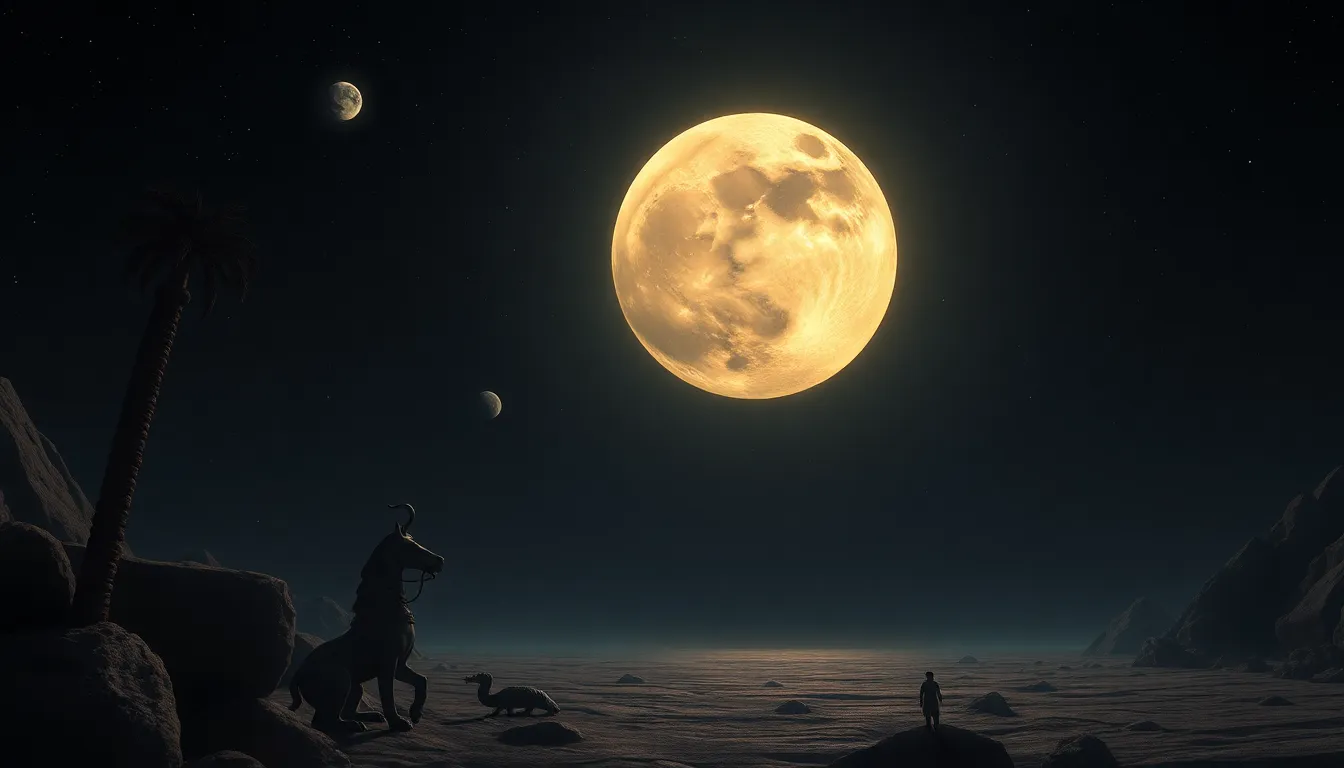The Moon in Egyptian Literature: Stories from the Past
I. Introduction
The Moon has held a significant place in the hearts and minds of ancient Egyptians, revered not only for its beauty but also for its profound connection to the rhythms of life. In ancient Egyptian culture, the Moon was seen as a powerful symbol of time, fertility, and the afterlife. This article aims to explore the role of the Moon in Egyptian literature, highlighting its multifaceted significance and its enduring impact on the cultural narrative of ancient Egypt.
II. The Moon as a Symbol in Egyptian Mythology
Within the realm of Egyptian mythology, the Moon was personified by the god Khonsu, who played a critical role in the pantheon of deities.
A. The Moon God Khonsu and His Attributes
Khonsu, often depicted as a youthful figure with a sidelock of youth, embodies the Moon’s changing phases. His attributes include:
- The lunar disc on his head, symbolizing the Moon itself.
- A sistrum, indicating his connection to music and fertility.
- A staff representing protection and guidance.
As a god of time and healing, Khonsu was believed to influence the cycles of the Moon, thus affecting life on Earth.
B. The Connection Between the Moon and Time, Cycles, and Fertility
The Moon’s phases were closely linked to the agricultural calendar, marking the times for planting and harvesting. This cyclical nature made the Moon a symbol of fertility and regeneration, as well as a guardian of time. The Egyptians closely observed lunar cycles, celebrating them through various festivals that honored the rhythms of nature.
III. The Role of the Moon in Creation Myths
The Moon’s involvement in creation stories is a fascinating aspect of Egyptian mythology. Various myths illustrate the Moon’s significance as a creative force.
A. The Moon’s Involvement in the Creation Stories
In some creation myths, the Moon is depicted as emerging from the primordial waters, symbolizing the beginning of life and the establishment of order from chaos. This emergence signifies the birth of time itself, with the Moon marking the passage of days and seasons.
B. Comparative Analysis of Lunar Themes in Different Myths
Comparing the lunar themes across various myths reveals a shared understanding of the Moon as a vital element in the cosmic order:
- In the Heliopolitan creation myth, the Moon is associated with the god Atum, who created the first gods.
- In the Memphite theology, the Moon is linked to the god Ptah, emphasizing the act of creation through thought and word.
These myths collectively highlight the significance of the Moon in the ancient Egyptians’ understanding of existence.
IV. The Moon in Poetry and Prose
The Moon’s beauty and symbolism are prevalent in ancient Egyptian poetry and prose, where it serves as a muse and metaphor.
A. Examination of Poetic References to the Moon in Ancient Texts
Poets often invoked the Moon to express themes of love, longing, and the passage of time. The Moon’s silvery glow served as a backdrop for romantic encounters and reflective solitude.
B. Notable Literary Works Featuring the Moon and Their Interpretations
One notable work is “The Love Songs of the Nubian,” where the Moon is portrayed as a witness to lovers’ trysts. Such references encapsulate the timeless nature of love and desire, linking human emotions to celestial movements.
V. The Moon and the Afterlife
The Moon’s symbolism extends into beliefs about the afterlife, where it plays a crucial role in guiding souls on their journey.
A. The Moon’s Representation in Funerary Texts and Beliefs About the Afterlife
In funerary texts, the Moon is often associated with the journey of the deceased. It symbolizes rebirth and the cyclical nature of life and death.
B. Symbolism of the Moon in Guiding Souls and Its Association with Rebirth
The Moon is seen as a guiding light for souls navigating the afterlife. This connection emphasizes the belief in resurrection, as the Moon waxes and wanes, symbolizing the continuous cycle of life.
VI. Historical Context of Lunar Worship
The worship of lunar deities evolved throughout ancient Egyptian history, adapting to changing societal needs and beliefs.
A. The Evolution of Lunar Worship in Ancient Egyptian Society
Initially, lunar worship was prominent in early dynastic periods, later becoming intertwined with solar worship as the state religion developed. However, the Moon retained its significance, particularly in rural practices.
B. Influence of Lunar Phases on Agricultural Practices and Festivals
Lunar phases dictated agricultural activities, with the new moon signaling planting and the full moon marking harvest times. Festivals celebrating these cycles reinforced the connection between lunar worship and everyday life.
VII. The Moon in Modern Interpretations of Ancient Texts
Contemporary scholars and artists have revisited the significance of the Moon in ancient Egyptian literature, offering new interpretations and adaptations.
A. Contemporary Scholars’ Views on the Moon’s Literary Significance
Modern analyses highlight the Moon’s role as a powerful metaphor for life, death, and regeneration, emphasizing its enduring relevance in literary studies.
B. Adaptations of Egyptian Lunar Themes in Modern Literature and Art
Artists and writers continue to draw inspiration from Egyptian lunar themes, incorporating them into modern narratives that explore identity, spirituality, and the human experience.
VIII. Conclusion
The Moon’s multifaceted role in Egyptian literature reveals a complex interplay between celestial phenomena and human experience. From its representation in mythology and poetry to its significance in agricultural practices and beliefs about the afterlife, the Moon remains a powerful symbol in the cultural narrative of ancient Egypt. As we reflect on these ancient stories, we recognize their lasting impact on contemporary culture, reminding us of the profound connections between humanity and the cosmos.




